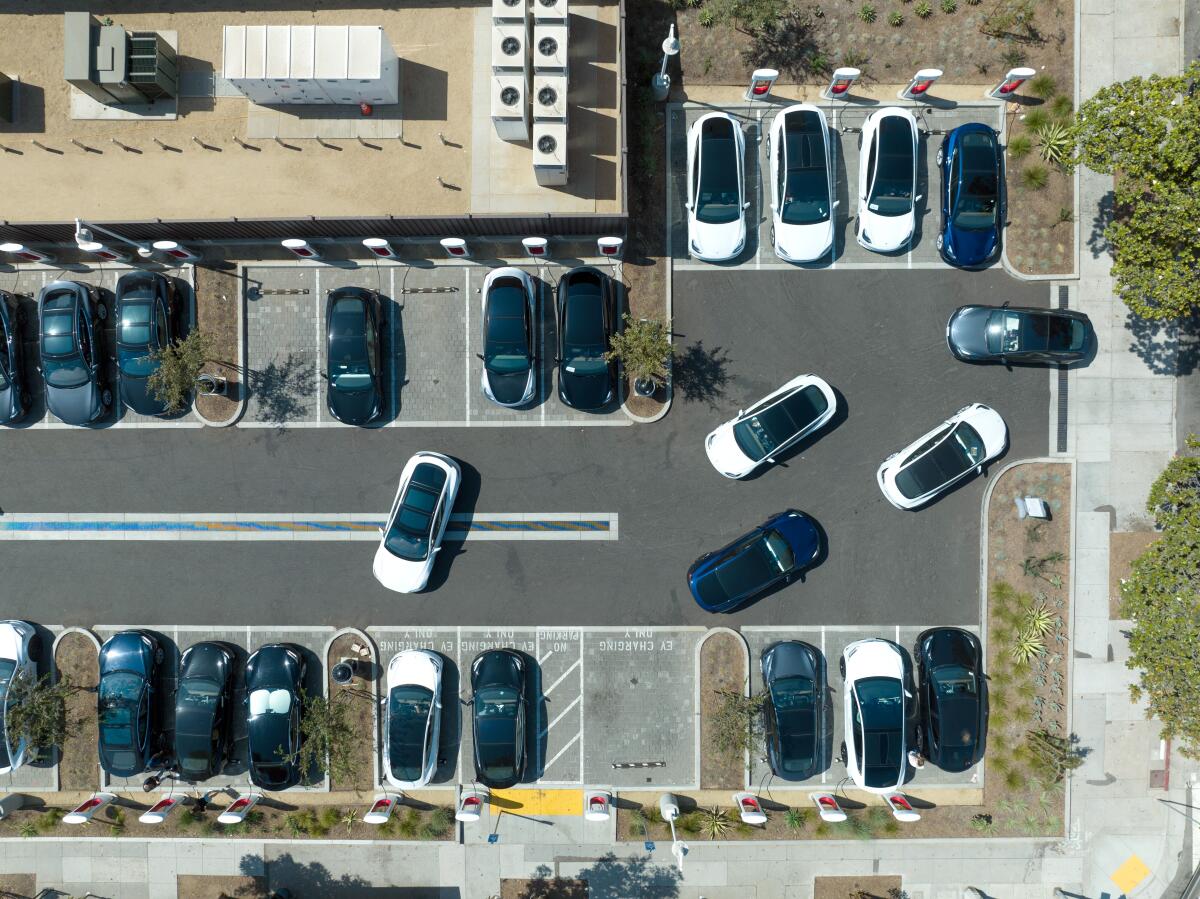California bans sales of new gas-powered cars by 2035. Now the real work begins

- Share via
Buy a car in 2035 and you won’t have to decide between gasoline, diesel or electric. You won’t have a choice.
Citing an urgent need to address climate change while cutting back on air pollution, the California Air Resources Board voted Thursday to require all new cars and light trucks sold by 2035 to be what it calls zero-emission vehicles.
Lauren Sanchez, Gov. Gavin Newsom’s climate advisor, called it “a huge day not only for California but the entire world.”
The mission, she said: “Move the state away from oil.”
The move marks a historic turn in the decades-long battle to curb motor vehicle pollution, a momentous shift for consumers, industry, the economy and the environment.
California has led the nation in auto emissions regulation since the air resources board was created in 1967 to combat the toxic yellow-brown smog that hung over Los Angeles. The state’s large population meant automakers could not ignore California’s mandates. Congress gave California permission to set its own rules decades ago, and California’s emissions and fuel efficiency rules have been adopted by more than a dozen other states.
Even with that prodigious record, the zero-emission mandate “is the most important and transformative action that [the air resources board] has ever taken,” said Dan Sperling, founding director of the Institute of Transportation Studies at UC Davis.
The mandate forces automakers to phase out gasoline and diesel cars, sport utility vehicles, minivans and pickup trucks in favor of cleaner versions powered by batteries or fuel cells.
If automakers fall short, they could be charged $20,000 per noncomplying vehicle, the air resources board said. If consumers don’t go along? That could cause big problems. But state officials think they will, and the trend line lends confidence.
Electric cars are rapidly gaining popularity in California. In 2012, less than 2% of new vehicles sold were electric. That grew to 7% in 2018.
But demand has surged since, and now 16% of new cars sold in the state are plug-in vehicles — battery-electric vehicles, led by Tesla, plug-in hybrids, plus a smattering of vehicles that run on hydrogen fuel cells. There are now 1.13 million zero-emission vehicles registered in California, according to the air resources board — 43% of the nation’s total.
Once considered little more than glorified golf carts with paltry range, electric cars now can travel several hundred miles on a single charge, in models that range from small commuter cars to luxury vehicles to SUVs, pickup trucks and muscle cars.
Under the new rules, 35% of new cars must be zero emission by 2026, 68% by 2030, and 100% by 2035.
People could still buy internal combustion cars from another state. But many states, including most of its neighbors, tend to follow California’s lead on vehicle emissions policy and are considering mandates of their own.
The effects of the 2035 mandate will be far-reaching, the air resources board said. It “will essentially end vehicle emissions altogether,” board Chair Liane Randolph told reporters.
Not quite. As Randolph herself noted, owners of internal combustion cars can continue to drive them after 2035. It will still be legal to buy and sell used fossil-fuel cars and light trucks.
The mandate doesn’t cover all of highway transportation, either. Heavy trucks that burn diesel fuel will have 10 extra years before they’re banned. A proposed zero-emission mandate for heavy trucks wouldn’t hit 100% until 2045.
In a nationwide first, California air quality officials will vote Thursday on a plan to phase out the sale of new gasoline-powered cars by 2035.
And even the zero-emission vehicle mandate includes vehicles that are not zero-emission. Up to 20% of a carmaker’s sales can be plug-in hybrids, which have both electric motors and gas engines, and still count as zero-emission vehicles, as long as the battery range is 50 miles or more.
The state uses “zero-emission” as shorthand, pertaining to the cars themselves as they move along the roadways. Recharging the batteries may well emit significant greenhouse gases, depending on what’s generating the energy: coal, oil and natural gas on the dirtier side; solar, wind, hydropower and nuclear on the cleaner. Creating hydrogen from water for fuel cells requires significant electricity, so greenhouse gas emissions again depend on the source.
Today, 40% of the energy generated for use by Californians is zero-carbon, including 8.5% from nuclear power. But the percentage varies by locality. For example, while coal accounts for only 2.7% of the state’s total power mix, 46% of Anaheim’s electricity is produced by burning coal.
Still, the air resources board’s vote marks a watershed in climate change policy.
Newsom ordered action two years ago and instructed the board to create a detailed plan. After several public hearings and testimony from hundreds of people and companies, the Thursday vote makes it official state policy. The U.S. Environmental Protection Agency must grant the state a waiver to set its own automobile emissions policies under the federal Clean Air Act, a likely slam-dunk under the Biden administration.
According to air quality officials, the new regulations would reduce greenhouse gas emissions from cars by more than 50% by 2040, compared with if no action were taken. Tailpipe emissions are the leading source of carbon dioxide in California and accounted for about 40% of the state’s greenhouse gas emissions in 2019.
With pickups outselling passenger cars in the U.S., Ford is betting big on the proposition that lovers of big, noisy trucks can be sold on the virtue of electric motors.
Additionally, state officials say the plan would cut smog-forming nitrogen oxides by more than 25% in 2037. They estimate the rule will result in over 1,400 fewer deaths from heart disease, and help Californians avoid more than 700 emergency room visits for asthma between 2026 and 2040.
Automakers have taken different positions on the mandate, ranging from enthusiastic to lukewarm to outright opposition.
Ford, which recently introduced its F-150 Lightning all-electric pickup truck, has worked closely with the air resources board.
In a statement, the automaker said that “combatting climate change is a strategic priority” and that the company is “proud of our partnership with California for stronger vehicle emissions standards, forged during a time when climate action was under attack.”
Toyota, which had placed big bets on its hybrid vehicles and lagged on pure-electric development, relented on its opposition and earlier this week sent the air resources board a letter recognizing its authority to set vehicle emission standards. The company had sided with the Trump administration on vehicle emissions issues.
Some environmental groups said the mandate doesn’t go far enough. Regina Hsu, a senior associate attorney for Earthjustice, noted that countries including Norway and the Netherlands have more ambitious timelines, and even Washington state has a plan to phase out new gas vehicles by 2030, although Gov. Jay Inslee’s commitment is nonbinding.
“The ramp that we see is not as stringent as it could be,” Hsu said. “Based on automaker projections, this rule is not that ambitious.”
But the transition to electric vehicles won’t be easy, and huge uncertainties remain.
Cost is one. An electric vehicle still costs far more than an equivalent gasoline vehicle. According to Kelley Blue Book, the average EV sold for $66,000 in July, compared with $48,000 for the average internal combustion vehicle.
In a presentation to reporters, air resources board officials pointed to studies that show savings in fuel and maintenance can make an EV a better financial deal over time, and that prices would continue to drop.
That’s not certain, however. Supply chain snags and shortages of crucial battery materials such as lithium and cobalt have cut back EV availability while boosting purchase price.
As EV costs remain high, green-oriented politicians feel pressure to offer incentives. The $369-billion climate package recently passed by Congress contains a significant increase in EV subsidies, including novel incentives on used cars.
Charging is another issue. While homeowners can install their own EV charger in a garage, most people who live in apartment buildings and condos don’t have that option. The state plans to require multifamily housing landlords to provide some way to charge electric cars, but the details are still being worked out.
Buying and installing an electric car home charger isn’t always easy.
Last year’s federal infrastructure legislation included billions of dollars for public fast-chargers to be installed at regular intervals on interstate highways.
As part of the California mandate, the state will require specific levels of warranty protection for EV batteries and related components. According to Randolph, that will not only protect new car buyers but also help ensure that reliable used EVs will become available.
“We understand that not everyone can buy a new car,” she said, pointing out several existing state programs that offer financial help for lower-income customers to buy EVs.
Brian Maas, president of the California New Car Dealers Assn., which represents more than 1,200 franchised new car and truck dealer members, said the organization is “all-in” on the transition to zero-emission vehicles.
“We just want to make sure that as we proceed along this path, we’re all working together to answer all these questions,” he said.
The biggest challenge could be customer acceptance at the 100% level. What happens if automakers can’t coax enough customers to buy?
Said Jennifer Gress, head of the Sustainable Transportation and Communities Division at the air resources board: “We always reserve the right to amend the regulations at any point.”
Times staff writer Tony Briscoe contributed to this report.













